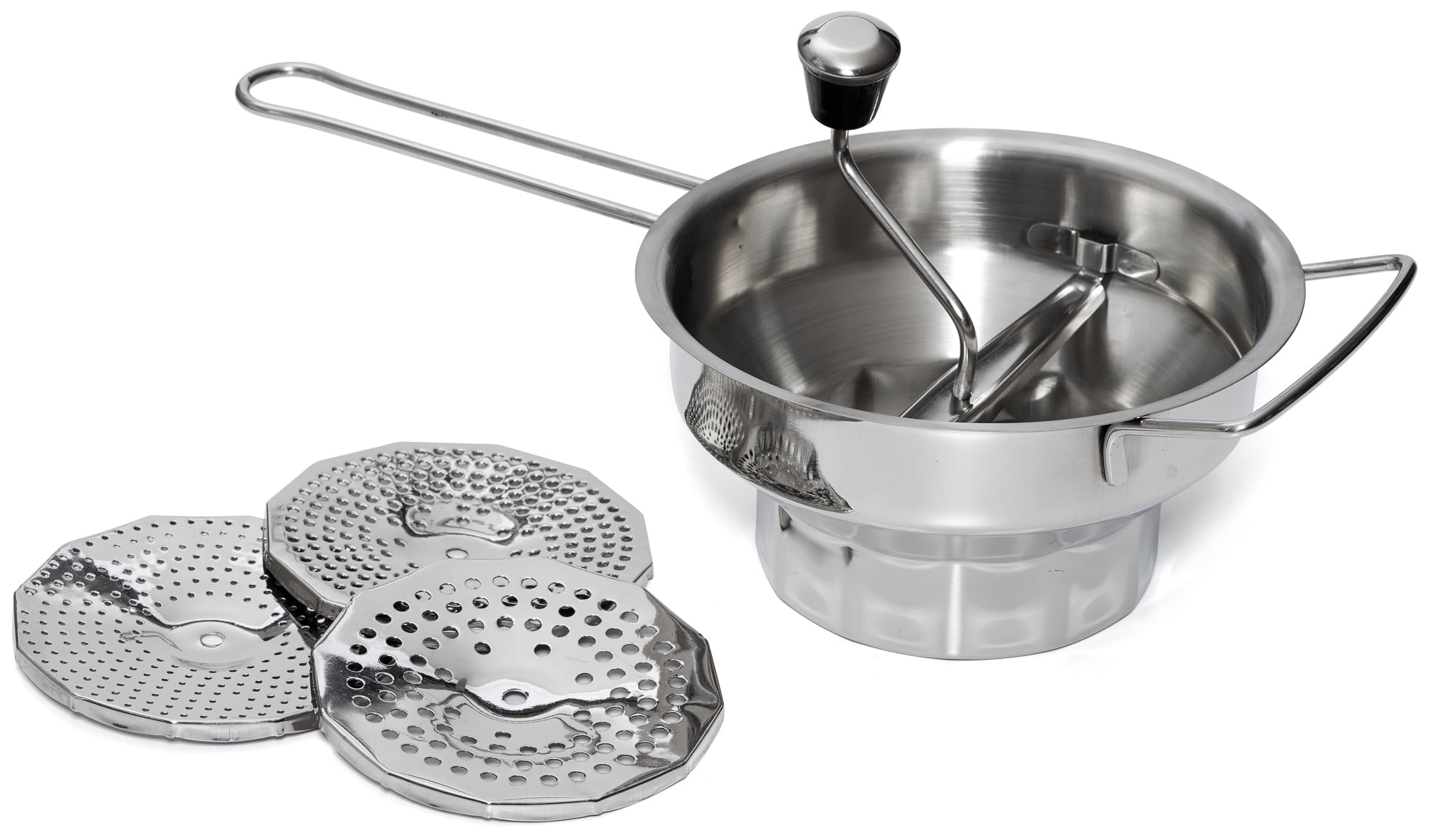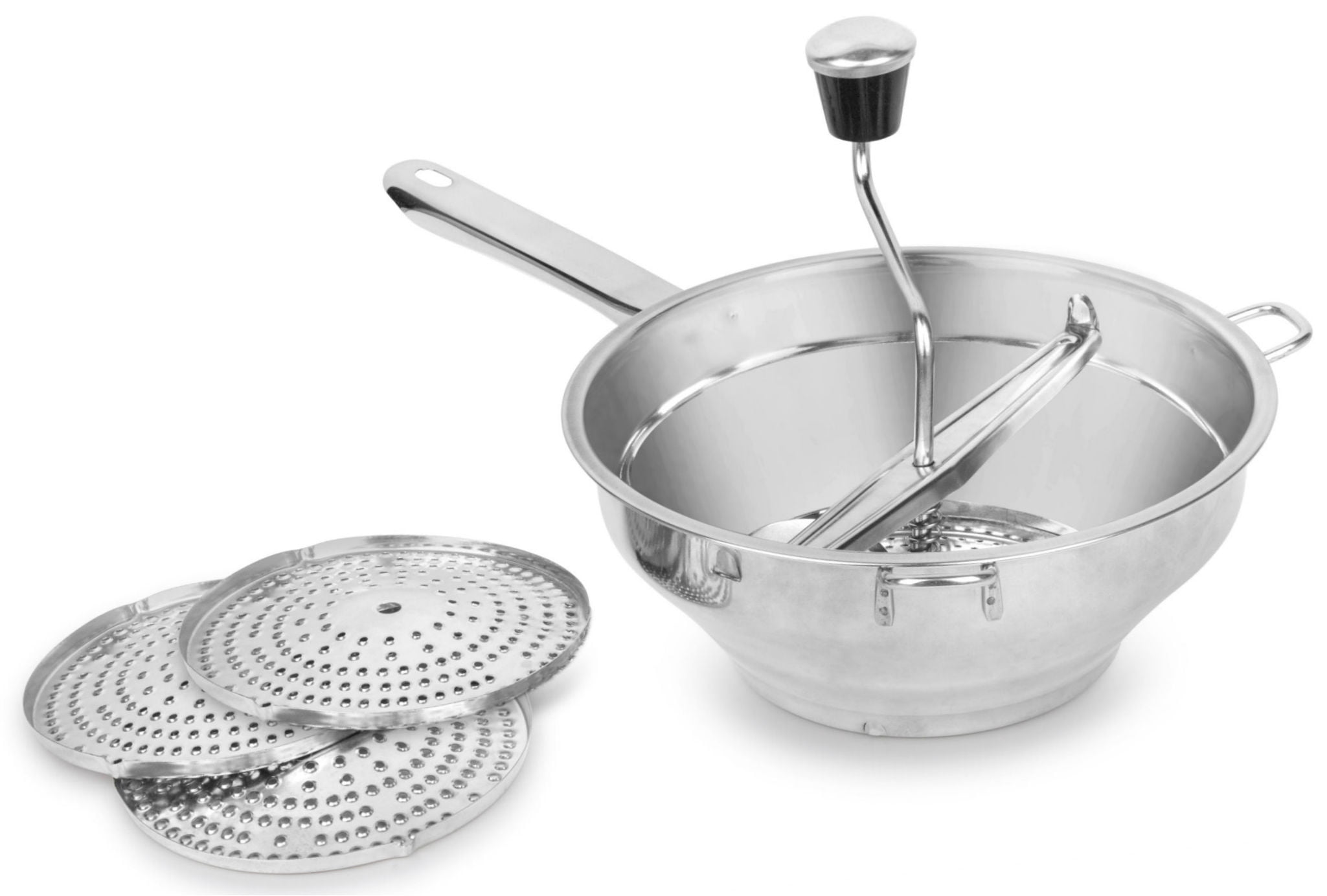Embark on a culinary adventure with food mills, the unsung heroes of the kitchen that transform ordinary ingredients into extraordinary creations. Dive into their history, functionality, and myriad culinary applications, unlocking a world of flavors and textures.
From pureeing soups to creating fluffy mashed potatoes, food mills offer versatility and precision that will elevate your cooking game. Discover the secrets of using this indispensable tool to achieve restaurant-quality results in your own kitchen.
Overview of Food Mills

Food mills are kitchen tools used to puree, strain, and separate food items. They consist of a hopper, a grinding disc, and a bowl or container. Food is placed in the hopper and manually or electrically pushed through the grinding disc into the bowl, resulting in a smooth, consistent puree.
Food mills are versatile and can be used to process a wide range of ingredients, including fruits, vegetables, cooked meats, and sauces.
The history of food mills dates back to the 18th century, with early models made of wood or metal. Over time, food mills evolved to incorporate new materials and designs, including the introduction of electric models in the 20th century.
Today, food mills are available in a variety of sizes, materials, and configurations to meet the needs of different users.
Types of Food Mills
There are several types of food mills available, each with its own advantages and uses:
- Manual Food Mills:These are hand-operated mills that require the user to manually turn a crank to push food through the grinding disc. Manual food mills are typically smaller and more affordable than electric models.
- Electric Food Mills:These are powered by an electric motor that automates the grinding process. Electric food mills are more convenient and faster than manual models, but they are also more expensive.
- Food Mill Attachments:These are attachments that can be used with stand mixers or immersion blenders. Food mill attachments offer the convenience of using an existing appliance, but they may not be as powerful or versatile as dedicated food mills.
Functionality and Usage: Food Mills
Food mills are simple yet effective tools that allow you to process a wide range of foods. They operate on the principle of grinding or pressing food through a perforated disc or screen, separating solids from liquids.
To use a food mill, simply place the food in the hopper and turn the handle. The food will be forced through the disc, with the solids remaining in the hopper and the liquids passing through the screen into a bowl or container placed beneath the mill.
Achieving Different Textures and Consistencies
The texture and consistency of the food processed with a food mill can be varied by changing the size of the holes in the disc. Larger holes will produce a coarser texture, while smaller holes will produce a finer texture.
Additionally, you can control the consistency of the food by adjusting the pressure applied to the handle. More pressure will produce a thicker consistency, while less pressure will produce a thinner consistency.
Benefits and Applications
Food mills offer a wide range of benefits and culinary applications. Their versatility makes them an indispensable tool in any kitchen.
Advantages of Using Food Mills
- Effortless Pureeing:Food mills efficiently puree fruits, vegetables, and meats, creating smooth and consistent textures without the need for a blender or food processor.
- Controllable Consistency:The interchangeable discs with varying hole sizes allow users to customize the coarseness or fineness of the puree, providing precise control over the desired texture.
- Preservation of Nutrients:Unlike blenders, food mills do not introduce air into the puree, preserving the delicate flavors and nutrients of the ingredients.
- Durable Construction:Food mills are typically made from sturdy materials like stainless steel or cast iron, ensuring longevity and durability.
- Easy Cleaning:Most food mills are designed with removable parts that can be easily disassembled and cleaned, making maintenance a breeze.
Culinary Applications of Food Mills
Food mills have a diverse range of culinary applications, from creating sauces and purees to making baby food and even crafting unique desserts.
Examples of Dishes Made Using Food Mills
- Smooth Sauces:Food mills are ideal for making silky-smooth sauces, such as tomato sauce, béchamel sauce, or hollandaise sauce.
- Fruit Purees:They can be used to create flavorful fruit purees for desserts, smoothies, or as fillings for pies and tarts.
- Vegetable Purees:Food mills can puree vegetables like carrots, potatoes, and squash, creating creamy and nutritious purees for soups, stews, or side dishes.
- Baby Food:Food mills are a convenient and safe way to make homemade baby food, ensuring the freshness and quality of ingredients.
- Desserts:They can be used to make velvety smooth mousses, custards, and even ice creams, adding a touch of elegance to any dessert.
Maintenance and Care

Maintaining your food mill is essential for ensuring its longevity and optimal performance. Proper cleaning and care will prevent clogs, corrosion, and other issues that can affect the mill’s efficiency.
Cleaning and Maintenance
After each use, disassemble the food mill and thoroughly clean all parts with warm, soapy water. Use a soft sponge or brush to remove any food residue or debris. For stubborn stains or odors, soak the parts in a solution of equal parts water and vinegar for 30 minutes before cleaning.
Once clean, rinse all parts thoroughly with clean water and dry them completely with a clean towel. This will prevent water spots and corrosion.
Troubleshooting
If you encounter any issues with your food mill, here are some common troubleshooting tips:
- Food is not being pureed smoothly:Check if the blades are sharp and clean. If necessary, sharpen or replace the blades.
- Food is getting stuck in the mill:Ensure that the food is cut into small pieces before processing. Also, check for any clogs in the mill’s hopper or outlet.
- Mill is leaking:Tighten the screws or bolts that hold the mill together. If the leak persists, check for any cracks or damage to the mill’s body.
Lifespan and Durability
With proper care and maintenance, a food mill can last for several years. The durability depends on the materials used and the frequency of use. Food mills made from high-quality materials, such as stainless steel, are more durable and resistant to wear and tear.
Comparison with Other Tools

Food mills are versatile kitchen tools, but they have their limitations. Comparing them to other kitchen tools can help you choose the best tool for your specific needs.
Blenders
- Advantages:Blenders can puree and liquefy ingredients, making them ideal for smoothies, soups, and sauces. They are also relatively easy to clean.
- Disadvantages:Blenders can’t separate solids from liquids, so they are not suitable for tasks like making applesauce or mashed potatoes. They can also be noisy and may not be able to handle tough ingredients.
Food Processors
- Advantages:Food processors can perform a variety of tasks, including chopping, slicing, shredding, and kneading. They are also more powerful than blenders, so they can handle tough ingredients.
- Disadvantages:Food processors are more expensive than blenders and can be more difficult to clean. They are also not as good at pureeing ingredients as blenders.
Strainers
- Advantages:Strainers are inexpensive and easy to use. They are also very effective at separating solids from liquids.
- Disadvantages:Strainers are not as versatile as food mills or food processors. They can only be used to separate solids from liquids, and they are not suitable for tasks like pureeing or chopping.
Ultimately, the best tool for you will depend on your specific needs. If you need a tool that can puree ingredients, a blender is a good choice. If you need a tool that can perform a variety of tasks, a food processor is a better option.
And if you need a tool that can separate solids from liquids, a strainer is the best choice.
Quick FAQs
What are the different types of food mills available?
Food mills come in various sizes and materials, including manual, electric, and stand-mounted models. Choose the one that best suits your needs and kitchen setup.
How do I clean and maintain a food mill?
Disassemble the food mill and wash all parts thoroughly with warm soapy water. Dry completely before reassembling for storage.
Can food mills be used to make baby food?
Yes, food mills are an excellent tool for making smooth, lump-free baby food. They gently puree fruits, vegetables, and meats, preserving their nutrients and flavors.
